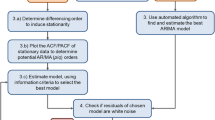Abstract
We introduce two types of ordinal pattern dependence between time series. Positive (resp. negative) ordinal pattern dependence can be seen as a non-paramatric and in particular non-linear counterpart to positive (resp. negative) correlation. We show in an explorative study that both types of this dependence show up in real world financial data.
Similar content being viewed by others
Notes
We state below how to deal with the case \(x_n=x_{n+1}\).
References
Bandt C (2005) Ordinal time series analysis. Ecol Model 182:229–238
Bandi FM, Renò R (2009) Nonparametric leverage effects. Working paper, Università di Siena
Barndorff-Nielsen OE, Shephard N (2002) Econometric analysis of realised volatility and its use in estimating stochastic volatility models. J R Stat Soc B64:253–280
Black F (1976) Studies of stock market volatility changes. In: Proceedings of the business and economic statistics section. American Statistical Association, New York, pp 177–181
Carr P, Wu L (2007) Stochastic skew in currency options. J Fin Econ 86(1):213–247
Emmerich Cvan (2007) A square root process for modelling correlation. PhD thesis, Bergische Universität, Wuppertal
Heston SL (1993) A closed-form solution for options with stochastic volatility with applications to bond and currency options. Rev Fin Stud 6:327–343
Keller K, Sinn M, Emonds J (2007) Time series from the ordinal viewpoint. Stoch Dyn 2:247–272
Keller K, Sinn M (2005) Ordinal analysis of time series. Phys A 356:114–120
Keller K, Sinn M (2011) Estimation of ordinal pattern probabilities in Gaussian processes with stationary increments. Comp Stat Data Anal 55:1781–1790
Lehmann EL (1966) Some concepts of dependence. Annu Math Stat 37:1137–1153
Madan DB, Yor M (2011) The S &P 500 index as a sato process travelling at the speed of the VIX. Appl Math Finance 18(3):227–244
Nagel H, Schöbel R (1999) Volatility and GMM - Monte Carlo studies and empirical estimations. Stat Papers 49:297–321
Romano M, Touzi N (1997) Contingent claims and market completeness in a stochastic volatility model. Math Fin 7:399–412
Sung SH (2012) Complete convergence of weighted sums under negatively dependent random variables. Stat Papers 53:73–82
Veraart AED, Veraart AMV (2010) Stochastic volatility and stochastic leverage. Ann Finance 8(2–3):205–233
Whaley RE (1993) Derivatives on market volatility: hedging tools long overdue. J Deriv 1:71–84
Whaley RE (2008) Understanding VIX. http://ssrn.com/abstract=1296743
Wilmott P (2000) Quantitative finance, vol 1. Wiley, Hoboken
Yu J (2005) On leverage in a stochastic volatility model. J Economet 127:165–178
Zarei H, Jabbari H (2011) Complete convergence of weighted sums under negative dependence. Stat Papers 52:413–418
Acknowledgments
The author wishes to thank two anonymous referees for their work. Their comments have helped to improve the paper. Furthermore he wishes to thank B. Funke (TU Dortmund) for carefully reading the manuscript and A. Dürre (TU Dortmund) for the implementation in R. The financial support of the DFG (German science Foundation) SFB 823: Statistical modeling of nonlinear dynamic processes (project C5) is gratefully acknowledged.
Author information
Authors and Affiliations
Corresponding author
Rights and permissions
About this article
Cite this article
Schnurr, A. An ordinal pattern approach to detect and to model leverage effects and dependence structures between financial time series. Stat Papers 55, 919–931 (2014). https://doi.org/10.1007/s00362-013-0536-8
Received:
Revised:
Published:
Issue Date:
DOI: https://doi.org/10.1007/s00362-013-0536-8




